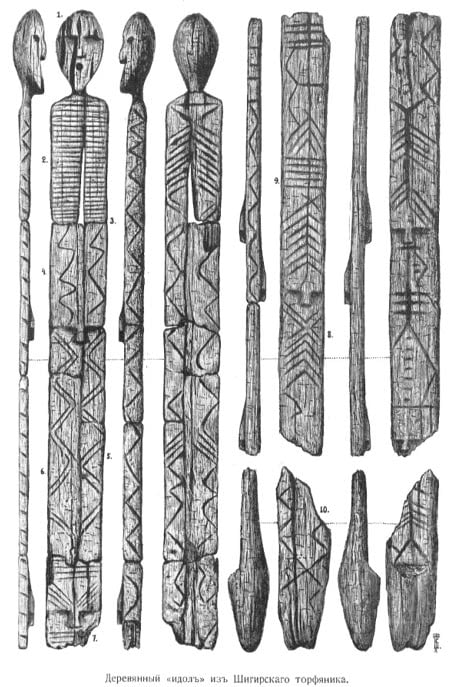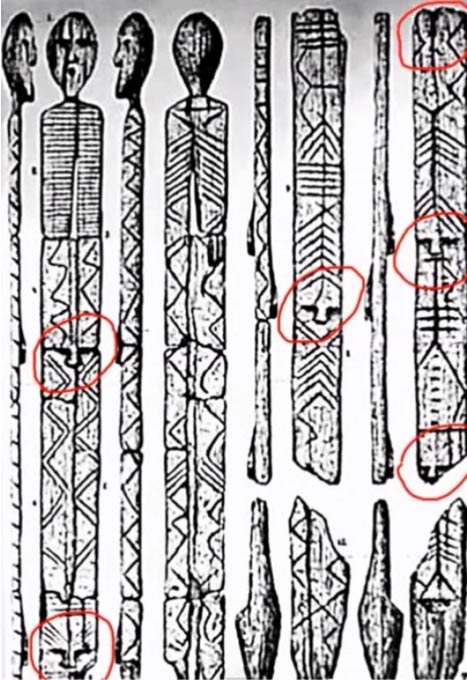
World Famous Shigir Idol is Twice as Old as Stonehenge! [New Study]
The incredible Shigir Idol, a wooden wonder from the prehistoric world, was dated to approximately 11,600 years old in 2018. Now, a new study has pushed that date back a further 900 years. This means that the world’s oldest known wooden statue is more than twice as old as Stonehenge!
Pinpointing the Astounding Age of the Shigir Idol
The new study is published in Quaternary International and demonstrates that given the age of 12,500 years old, the haunting humanoid statue is also more than twice as old as the pyramids of Giza - a status made even more amazing by the fact that it is made of wood. The paper’s lead author, Thomas Terberger, an archaeologist at the Department of Cultural Heritage of Lower Saxony, Germany, proposed a reason behind the statue’s creation to the New York Times:
“The idol was carved during an era of great climate change, when early forests were spreading across a warmer late glacial to postglacial Eurasia. The landscape changed, and the art—figurative designs and naturalistic animals painted in caves and carved in rock—did, too, perhaps as a way to help people come to grips with the challenging environments they encountered.”

Illustration of the Shigir Idol. (Public Domain)
The Shigir Idol’s Many Faces
Standing taller than a two-story building—it is 2.8 meters (9.2 feet) long, though it was originally 5.3 meters (17.4 feet) before lengths of the artifact were accidentally destroyed during the Soviet era—the idol is thought to have been a large tree that was more than a century old, which was shaped and decorated using a stone spoon implement.
The body of the prehistoric sculpture is flat and rectangular, and horizontal lines cross at approximately chest level, appearing to represent ribs. The ancient artists gave the idol seven faces at different levels of the statue, suggesting to academics that the positions likely relate to a hierarchy. Three figures are located one above the other on both the front and the back, and a seventh figure connects both sides, completing the composition.

An early reconstruction of the Shigir Idol from 1894. (Sverdlovsk Regional Museum)
Researchers believe that the idol’s high cheekbones and straight nose may reflect what the creators looked like at the time.
Does the Statue Contain a Coded Message?
The incredible wooden sculpture was pulled from a peat bog in the in the western fringes of Siberia, Russia, 125 years ago. As if in a time capsule, the idol sat excellently preserved some four meters (13.5 feet) below the ground, protected by the antibacterial properties of peat, which prevented decomposition.

Shigir Idol - the oldest known wooden sculpture in the world. (CC BY-SA 3.0)
The sculpture was found in numerous fragments, but when pieced together, it was discovered the surface was covered in Mesolithic symbols and geometric designs, including chevrons, straight lines, herring-bone hatching, squiggly lines, and more. If these are a purposeful message of primitive writing, it would make the Shigir Idol the world’s oldest code on the planet.
- Voices of the Dead: The Strange Origins of Eye Idols
- The Dispilio Tablet - the oldest known written text
These mysterious markings have not been deciphered as of yet, but many suspect they may carry encoded information. If translated, we may glean information on Mesolithic man’s understanding of the natural and spiritual world.

Does the Shigir Idol contain coded messages? “Faces” appear throughout the sculpture. (YouTube Screenshot)
Professor Mikhail Zhilin of the Russian Academy of Sciences’ Institute of Archaeology believes this might be the case, saying, “This is a masterpiece, carrying gigantic emotional value and force. It is a unique sculpture, there is nothing else in the world like this… The ornament is covered with nothing but encrypted information. People were passing on knowledge with the help of the Idol.”
The messages remain “an utter mystery to modern man”, but Zhilin says the prehistoric craftsmen must have “lived in total harmony with the world, had advanced intellectual development, and a complicated spiritual world.”
The new research is a victory for Russian academics, who had been defending the idol’s age to some skeptics in the scientific community. Natalia Vetrova, general director of the Sverdlovsk Regional History Museum told the Siberian Times in 2018 that earlier claims of the Shigir Idol’s antiquity “were not recognized by the international scientific community. And we wanted to know for sure, and tell the world how old our Idol is.”
A Glimpse into the Lost World of Prehistoric Woodworking
Terberger also says that “This is an extremely important data for the international scientific community. It is important for understanding the development of civilization and the art of Eurasia and humanity as a whole.”
With its complex iconography, the Shigir Idol also presents archaeologists with new perspectives on the hunter-gatherer societies of Europe and Asia at the time of its creation and into prehistoric woodworking. It reveals that the artwork of the time was more diverse than the animal images and hunting scenes which are commonly linked to that period.
- Is the Danube Valley Civilization script the oldest writing in the world?
- World’s oldest times table found on ancient Chinese bamboo strips
Despite the fact that Paleolithic artists living in forested regions would have had an ample supply of wood available to them, much of their artwork has likely been lost because the wooden creations would have deteriorated over the centuries, unless they’ve been preserved in ideal conditions such as the peat bog which saved the Shigir Idol. As the scientists argue in their paper, “Wood working was probably widespread during the Late Glacial to early Holocene. We see the Shigir sculpture as a document of a complex symbolic behavior and of the spiritual world of the Late Glacial to Early Mesolithic hunter-gatherers of the Urals.”

Head of the Shigir Idol, the world's oldest known wood sculpture. (Sverdlovsk Regional Museum)
Further excavations of the many unexplored peat bogs in the Urals may reveal more examples of prehistoric wooden artwork. However Artnet notes that “a lack of funding means that there are currently no ongoing excavations” in this area.
Top Image: The Shigir Idol. Source: Terberger et al., Quat. Int., 2021
By Liz Leafloor
Updated on March 25, 2021.















Comments
So it's about 17 ft. tall so almost 2 stories tall Apt. Bldg. wise. Though it may have been taller, being that it may have been driven into the ground. And with the figure head on top with several faces & symbols carved along the length of this work may prove this item to be the 1st known Totem Pole! The top head & the faces beneath may indicate the 1st example of worship of a pantheon of gods/spirits in human history. This totem-pole was found in a bog which may indicate that it was an offering to those same gods/spirits. This is going by the so-called ‘Bog-People' finds in northern European bogs who may have been human offerings to the gods. As for the other sybols on the carving such as the cheveron perhaps calls for a Culteral Anthropologist or even an Artist's point of view to interpret.
The mysterious markings on the wooden idol are possibly the result of an extreme cosmic occurrence witnessed by the idol’s initiator.
Looking at Tolmachev’s rendering of the Shigir Idol statue (far right rendering with three red circles), it is displaying characteristics of high energy plasma discharges as indicated by the branching “limbs” along the vertical “trunk” line forming chevron patterns. These “branches” when observed in high energy plasma discharges can be rising, lowering or straight across depending on the time track of the discharge.
This pattern is known as a Columnar stack of Plasma Toroids or characterized as a Pipette, and has similarly been observed in rock art found throughout the world.
The additional faces in the idol are also characteristics of high energy plasma discharges which have been documented scientifically from recordings in the laboratory and with computer simulation.
Without scientific data, conclusions remain conjecture.
Human history and world history remains a dark mystery. Russia has many ancient human structures, many probably older than even Sumerian civilization.
Something terrible happened to this planet in the not very distant past. Not so long ago, the earth had a completely different north and south polar axis system. Something not only changed the earth’s poles, but in essence flipped our globe sideways, so now we have a north pole where before we hade a “west” or “east” pole.
Human legends around the globe say almost everyone died. Genetics confirms this, showing that within the lasts 70000 years of so, virtually all human beings died out, except maybe about 2000 of us.
We come down as the stabilized mutant ancestors or the people before us.
Tom Carberry
A two story building ha ha, people do need to exaggerate like idiots. Also there is no coded messages in this poorly portrayal of a statue that has two holes for eyes, a hole for a mouth, and a straight line for a nose. I bet the finder want $5 milllion dollars for what some people think is a treasure.. lol
Charles Bowles
They state that it was over 17 Feet at one time, however, a 2 story building would be at least 20 feet.
Pages